Car Engine Loses Power and Acceleration When AC Is On: 7 Potential Causes
It’s a hot summer day, and you turn on the AC in your car to stay cool. But as soon as you do, you notice your “car loses power and acceleration when ac is on“. The engine seems to struggle, almost like it can’t handle the extra load of the AC compressor
In this guide, we’ll look at some potential causes and solutions for when your car loses power and struggles to accelerate when the AC is on.
First off, the AC puts additional strain on the engine, reducing its power and acceleration. So, the engine has to generate more power to overcome the strain exerted by the AC.
So, why car performance drops when ac is on? When a car loses power with the AC on, several issues could be responsible: a clogged air filter restricting engine’s airflow, a blocked condenser, an improperly tensioned serpentine belt, or a faulty fuel pressure regulator. A malfunctioning alternator, a slack timing chain/belt leading to incomplete combustion, or a dirty throttle body can also cause this power loss. Regular checks and maintenance can help ensure optimal performance.
Are you confused what will happen if you leave your AC on while car is parked? You can read my guide on that topic to learn more.
Does Ac Affect Engine Power?
When the AC is running, the engine has to work harder to power the compressor and condenser fan, which means it has less power to accelerate the car. This means that acceleration might be slightly reduced when the AC is running. However, the effect is usually not noticeable and wouldn’t greatly affect the performance of your car.
The main effect of having an air conditioner in your car is on your fuel economy. Having an AC in your car uses up engine power, which means more fuel is being used. This is because the compressor needs energy to run, and this energy is taken from the engine. The result is that fuel usage increases slightly when the AC is running, as more power is being used.
Note: Keep in mind that the AC condenser fan and AC blower run from the car battery while the AC compressor runs from the engine crankshaft which supplies power through the serpentine belt to the AC compressor pulley.
However, there is a magnetic coil inside the AC compressor clutch that gets 12V from the battery to energize itself and engage A/C clutch drive plate inward with the pulley. AC compressor clutch engages and disengages with the pulley to maintain
Wondering how to reduce AC load on engine if your car is sputtering? You can read my guide on that topic to learn more.
Also, note that some cars also tend to turn off AC compressor under hard acceleration to ease off the extra strain on the engine, and to reduce the power loss.
Causes of Decrease in Car’s Power With Air Conditioner On
If you experience a sudden drop in power and acceleration when you turn on the air conditioning (AC) in your car, you may be concerned and confused. There could be several possible causes of this problem, so it’s important to take some time to identify the source of the issue.
Let’s take a look at some of the other potential causes of a car engine losing power and acceleration while AC is on:
1. Clogged A/C Condenser
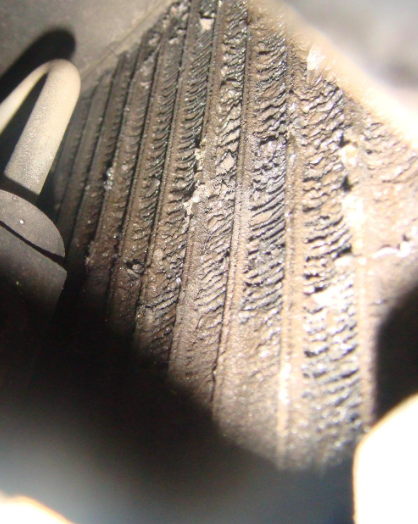
A clogged AC condenser can make your car struggle when the air conditioning is in use. The condenser itself doesn’t power the engine. But it affects how well the AC works. And that impacts engine performance.
The condenser cools the refrigerant in the AC system. When the condenser gets clogged with dirt and debris, it can’t cool properly.
The refrigerant then overheats. This causes excessive pressure of refrigerant in the AC system. This makes the AC compressor work extra hard. It uses more engine power. So there is less power for acceleration.
The result is reduced engine RPM and power when driving with the AC on. A clogged condenser indirectly causes the issue.
If your car is sputtering when ac is on, you can read my guide on that topic to learn more.
2. Bad Fuel Pressure Regulator
A vehicle’s fuel system relies on a special part called the fuel pressure regulator to keep everything running smoothly. This handy device sits at the fuel rail, acting like a watchful guard monitoring the rail pressure entering the engine.
When your vehicle is parked or moving slowly, the engine doesn’t need as much power. The fuel pressure regulator steps in to return extra fuel back to the tank, ensuring just enough pressure for a nice steady idle.
But when you hit the gas to drive faster, more air rushes into the engine. Sensing this, the regulator cuts off the return line to let more fuel flow through the injectors. This keeps the crucial air-fuel mixture in balance for efficient combustion.
The fuel pressure regulator constantly adjusts, opening and closing the fuel flow to maintain the ideal pressure. But if it gets damaged, trouble can flare up quickly.
Symptoms of a failing fuel pressure regulator include poor acceleration, rough idle, hard starting, and stalling – all signs of low fuel pressure. You may also notice dirt buildup around the throttle body from ruptured diaphragms allowing fuel seepage.
With inconsistent fuel pressure, the air-fuel ratio becomes lean. Now the engine has to work harder, producing less power overall. Turn on the AC, and acceleration drops even more under the extra load.
To check if the fuel pressure regulator is bad, you need to first measure the fuel pressure using the fuel pressure gauge kit. The optimum fuel rail pressure depends on the engine.
3. Clogged Air Filter
The air filter is the gatekeeper, only allowing clean air into the engine so your car can breathe properly. Without this first line of defense, debris would freely enter and damage the sensitive inner workings.
As a key player in your combustion system, engine air filter has an outsized role. When gunk builds up on the air filter, less and less oxygen flows through, choking the engine. Starved of this essential element, combustion suffers, sapping away horsepower.
With use, the color of an air filter dulls from bright white to a foreboding gray. But being out of sight, an old filter is often out of mind. To keep your engine running at peak performance, this inexpensive part needs a fresh swap every 20,000 miles or 12 months.
If your car is losing power when turning corners, you can read my guide on that topic to learn more.
3. Dirty Throttle Body
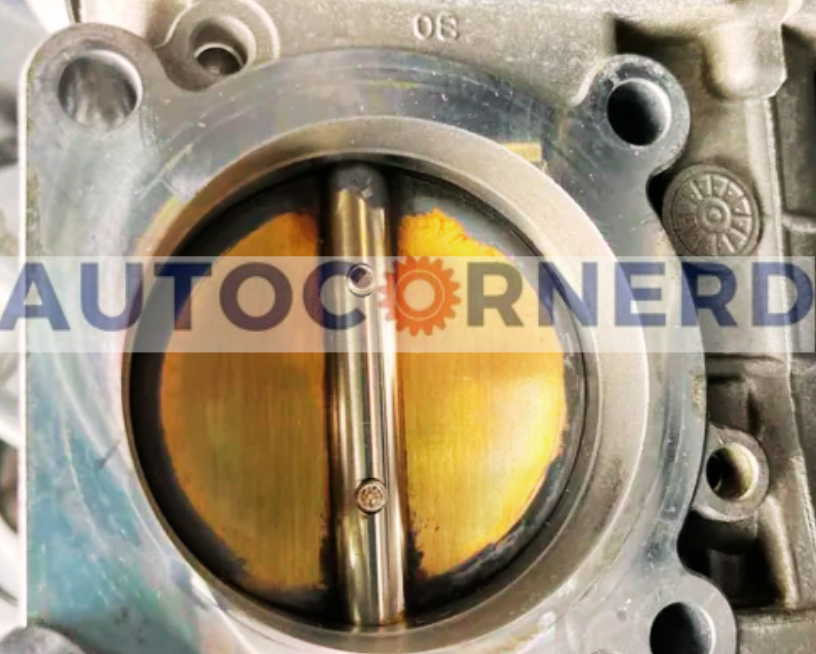
Keeping your engine’s airflow smooth and steady lets your car purr its best. Your throttle body makes that happen by controlling how much air enters the motor. But when sticky gunk builds up inside, airflow suffers—slowing you down when your AC kicks on.
That black grime is a mix of airborne dirt and oily deposits that keep the throttle plate from moving freely. Less airflow means less fuel burned. Without enough oomph, your engine struggles when the AC demands extra power.
A grubby air filter that passes debris inside. Leaky hoses spewing unfiltered air. Just normal operating grime that stacks up over time.
Whatever allows it, those sticky deposits stop your throttle plate from swinging open all the way. Choking airflow causes sputtering, hesitation, and slowdowns.
The fix is easy. Throttle body cleaner dissolves all that built-up gunk. Then give the plate a test flick—it should move without sticking. That keeps airflow smooth, fuel mixing precise, and power steady—no matter what extras you switch on.
4. Locked Up AC Compressor
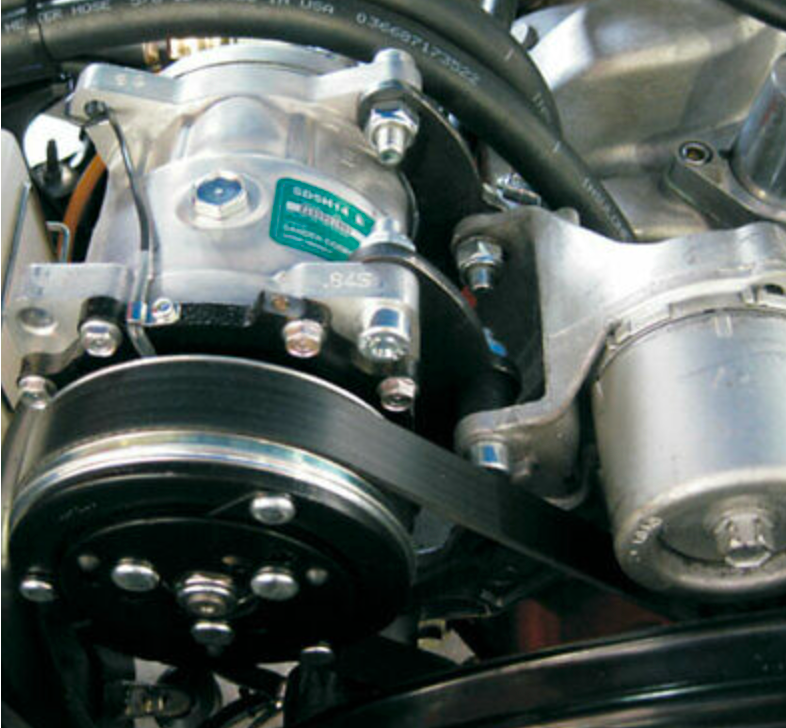
When your vehicle’s air conditioning is running, power and acceleration are imperative for transportation.
Unfortunately, compressor seizure can hinder these performance factors. The compressor pressurizes refrigerant within the air conditioning system before sending it to the evaporator.
This vital component connects to the engine via a belt powered by a pulley. Strain from a seizing compressor disrupts the engine, robbing acceleration.
How AC Compressor Siezes?
Lack of lubrication commonly causes compressor seizure, gradually wearing the component until failure.
The compressor requires continual lubrication to properly compress airflow. Insufficient lubricant wears the compressor, eventually causing it to bind.
Malfunctioning clutch components can also provoke seizing. The clutch engages the compressor to the engine. Over time, the clutch wears out, struggling to fully engage the compressor and provoking it to seize up.
How to spot the issue?
If the AC compressor is partially seizing, it could drag the engine down, due to which the serpentine belt may show signs of glazing or similar effects of heat caused by the belt having to work harder.
The serpentine belt may begin to lose its strength and elasticity, or it may even melt from all the chaffing and rubbing.
If you notice any glazing or melted spots on the belt, it’s a definite sign that your AC compressor is partially seized.
So, in that case, you have to check:
- AC compressor
- Compressor clutch
- Compressor pulley
Now, take the serpentine belt off the compressor pulley, and rotate the inner part of the compressor (shaft) by hand using an 8mm socket. It should rotate freely.
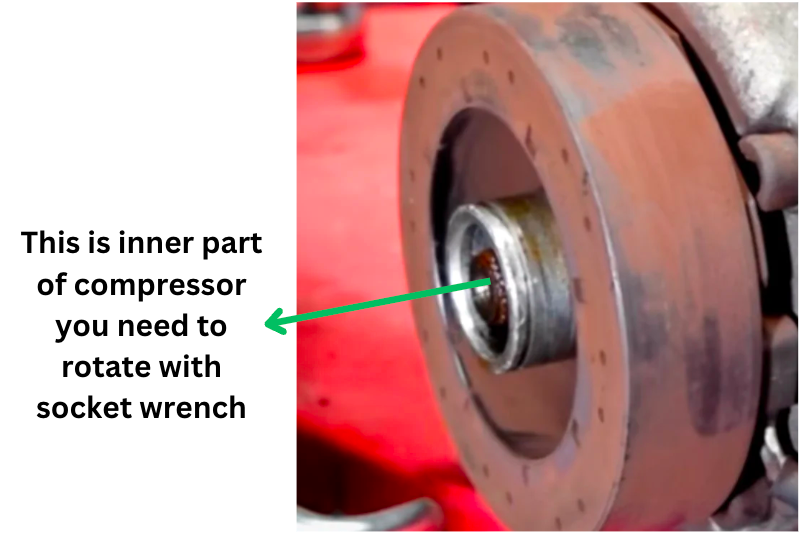
Now, try wiggling it and see if there is any excessive play. Similarly, also check the compressor pulley and compressor clutch. There should not have any play in the AC clutch.
5. Serpentine Belt Slipping
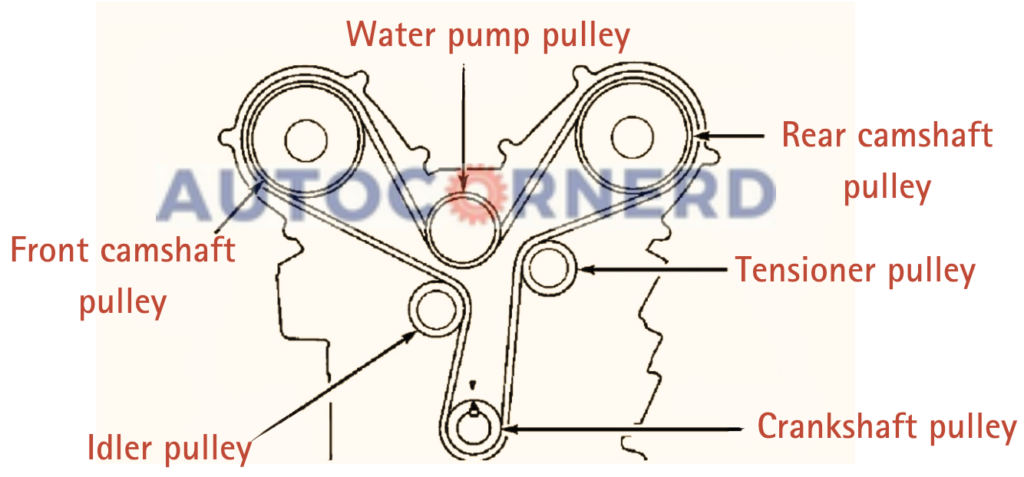
A serpentine belt is an integral part of any car’s engine. It’s responsible for connecting the crankshaft to the various components in the car, such as the alternator, power steering, water pump, and air conditioning compressor.
Serpentine belts are designed to last for a long time, but eventually, they will wear out and need to be replaced. When this happens, the belt will start to slip and you will begin to notice certain signs. These include:
- A screeching sound when the engine is running
- Squeaking noises as the belt pass the pulley
- A burning rubber smell
- A decrease in power and acceleration
You need to check the following aspects:
- Pulleys of the engine components, over which the belt passes, may not rotate freely. You should especially check the alternator pulley and compressor pulley. These pulleys should rotate freely.
- The tensioner and idler pulley might have a play in them. The Idler pulley of the serpentine belt should be fully tight.
- The belt may not fit all pulleys snugly.
- There might be more than 1-2cm slack in the serpentine belt.
6. Bad Alternator
The alternator keeps your vehicle moving down the open road. This key component churns out power to wake up the engine, keep it running smooth, and juice up the battery.
When the alternator starts fading, your engine’s performance drops. Without enough power under the hood, the car’s electrical system stops working properly.
The alternator’s job is to always keep the battery charged when driving, while the battery keeps the engine computer and sensors humming so your vehicle stays in peak form.
Fortunately, there are warning signs that can alert you to a failing alternator:
- Dimming or flickering headlights
- Slow-starting or stalling engine
- Odd readings on the car’s dashboard
- Battery light is on
When a car battery has low voltage due to a malfunctioning alternator, it can throw some random low voltage codes or loss of communication codes (U0100, U0140).
You can check them using OBD2 scan tool. Due to these trouble codes, the engine can go into a reduced power mode.
Furthermore, when the engine is running at high RPMs, the voltage of the battery should never drop below 13.5V. If it does, it means the alternator is bad.
7. Faulty AC Pressure Switches
The AC relies on pressure switches to synchronize refrigerant flow, with low and high-side sensors safeguarding operations. Failure risks power loss plus blurred acceleration when engaged.
The low-side pressure switch monitors system pressure entering the compressor, both to protect its limits and maintain charge.
If stuck engaged, it will keep the compressor working non-stop. When this happens, the compressor doesn’t get enough refrigerant and has to work extra hard to pump what little it has. This can lead to problems because the compressor is running “dry.”
The high-side pressure switch instead prevents condenser over-pressurization. A stuck ‘on’ mode allows the compressor to push well beyond optimum head pressure from excess refrigerant. Either failed switch can enable mechanical damage from overwork flirting with the engine stall.
So for smooth running AC, expect low side readings between 30-50 PSI, with high side peaks around 250 PSI during standard operation.
Note: You’ll find a low-side pressure switch between the evaporator and compressor, a high-side pressure switch between the compressor and condenser.
How Much Horsepower Do You Need For A Car AC?
The car’s air conditioning system requires a certain amount of power to keep it running efficiently. There are several factors that determine the power needed for a car air conditioner, including the size of the vehicle, the type of climate in which you live, and the size of the AC compressor.
In general, the amount of horsepower needed for a car AC will range from 3 to 10 HP or 5% of the total engine’s horsepower. This is enough to keep the car’s air conditioning running at its optimal efficiency.
However, it is important to note that if the car is larger or if the climate is particularly hot, more horsepower may be needed to keep the air conditioning running effectively.
